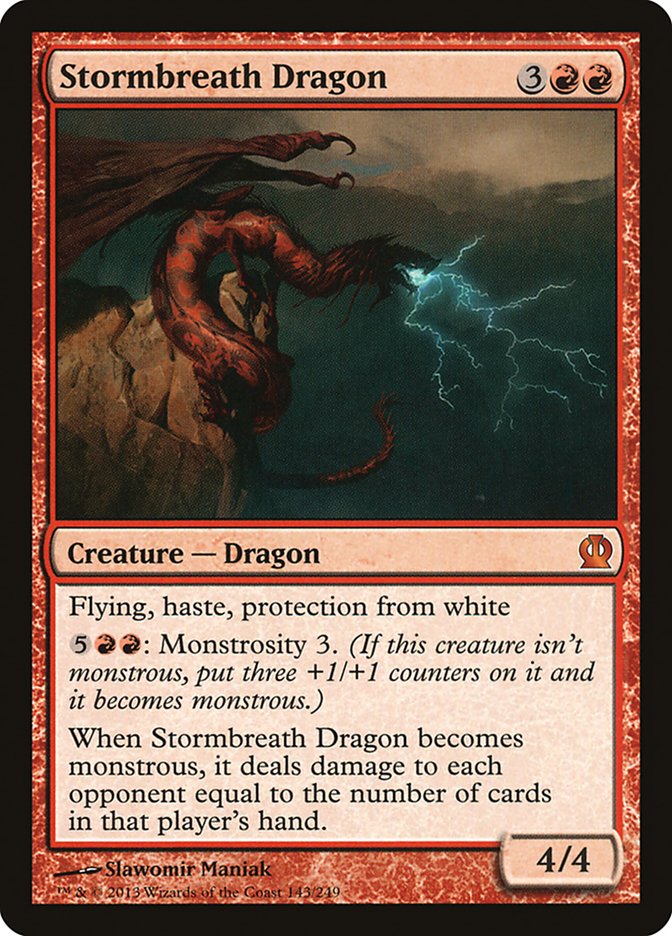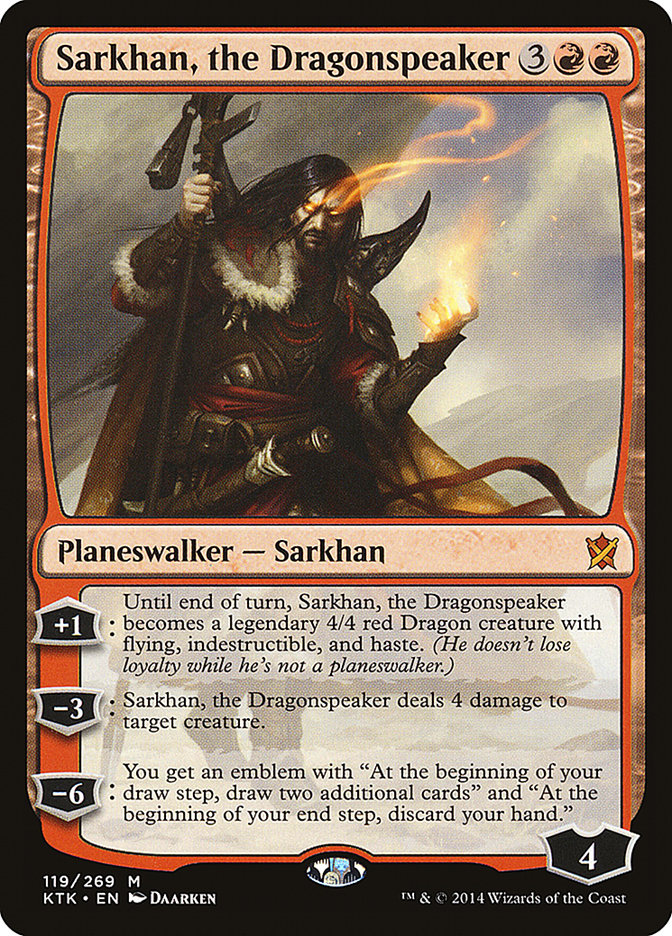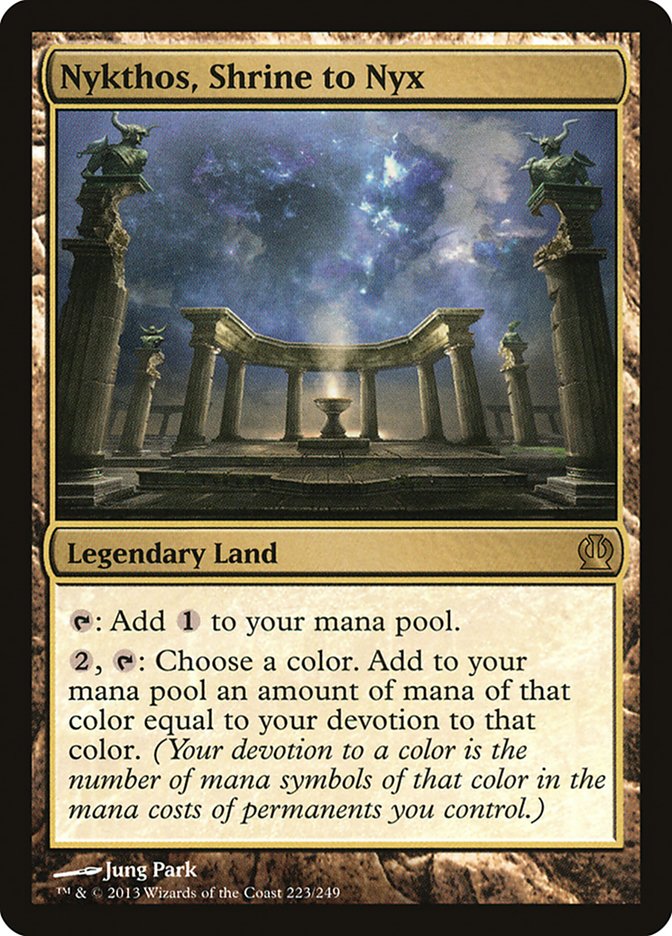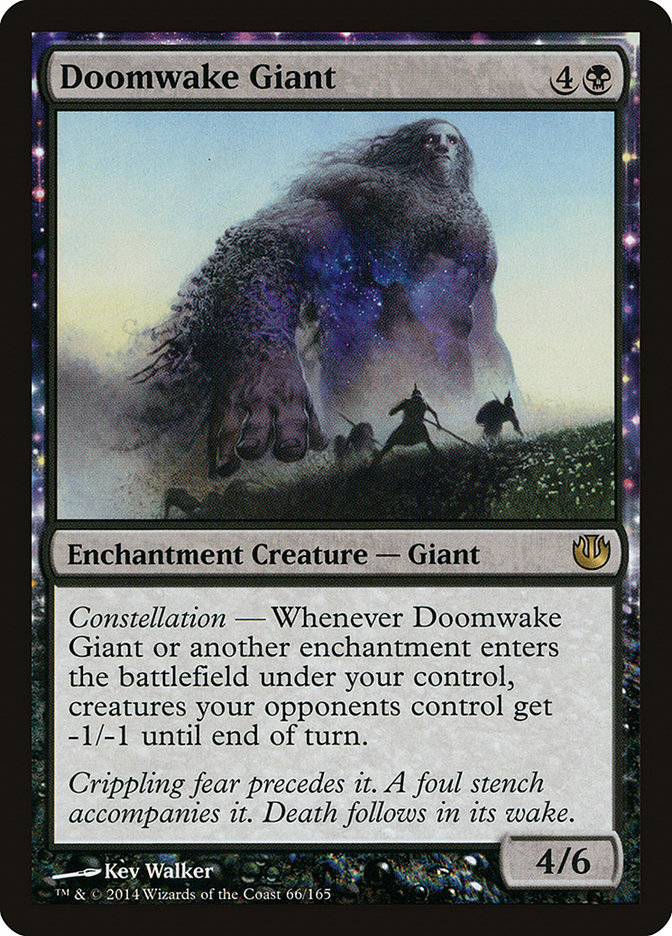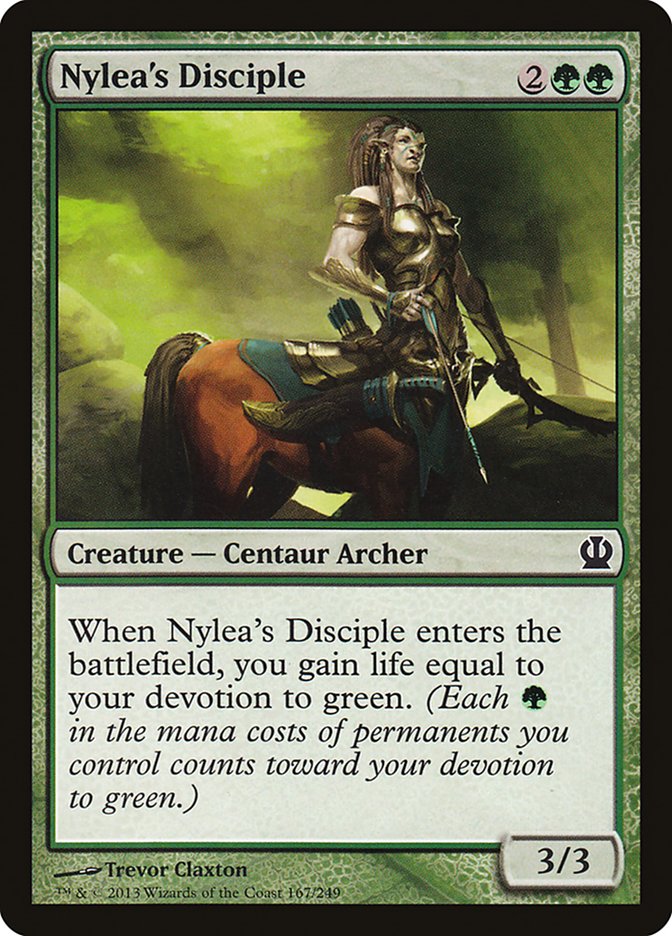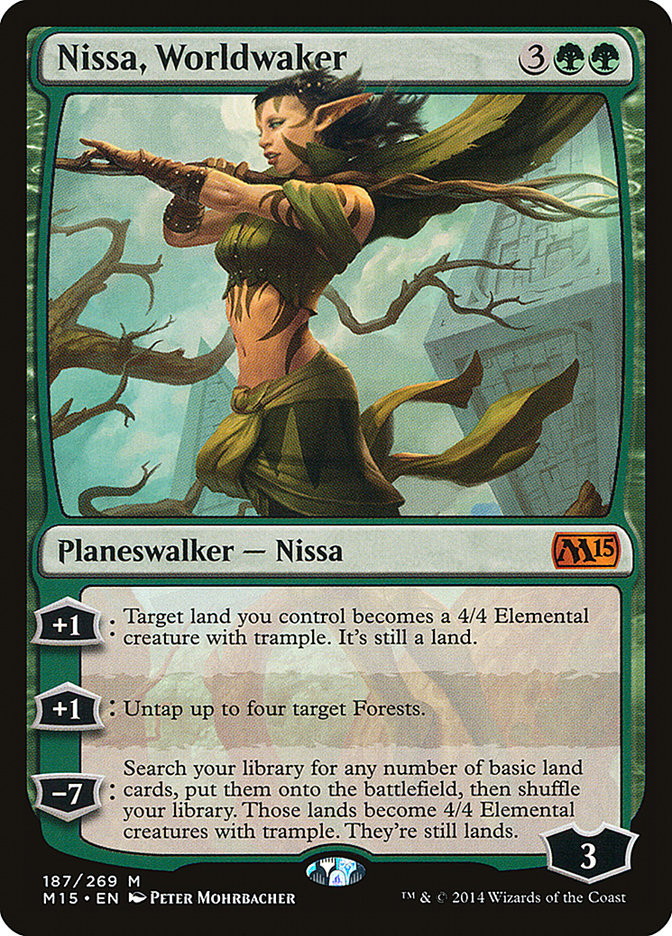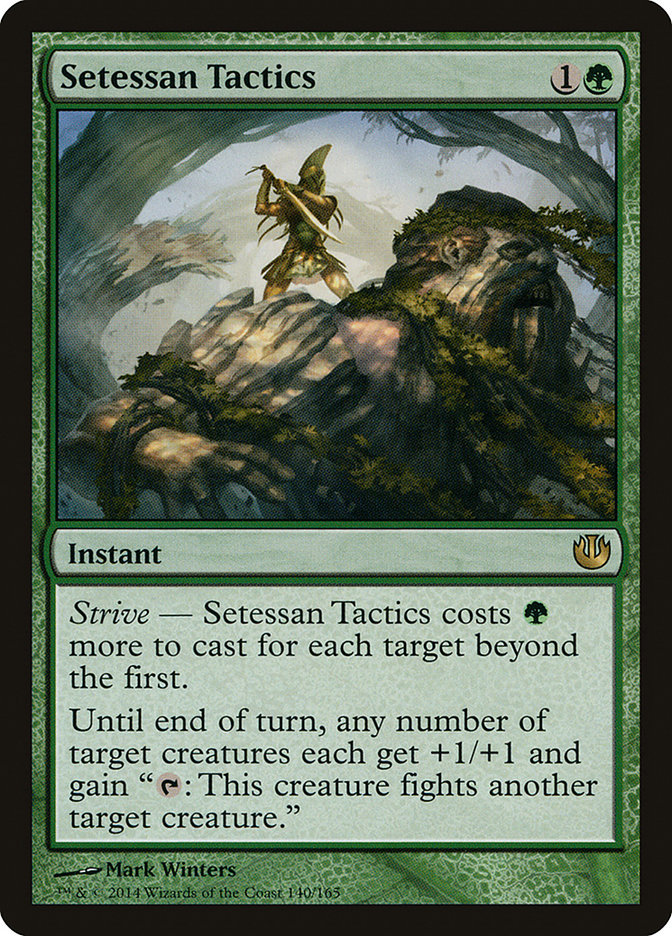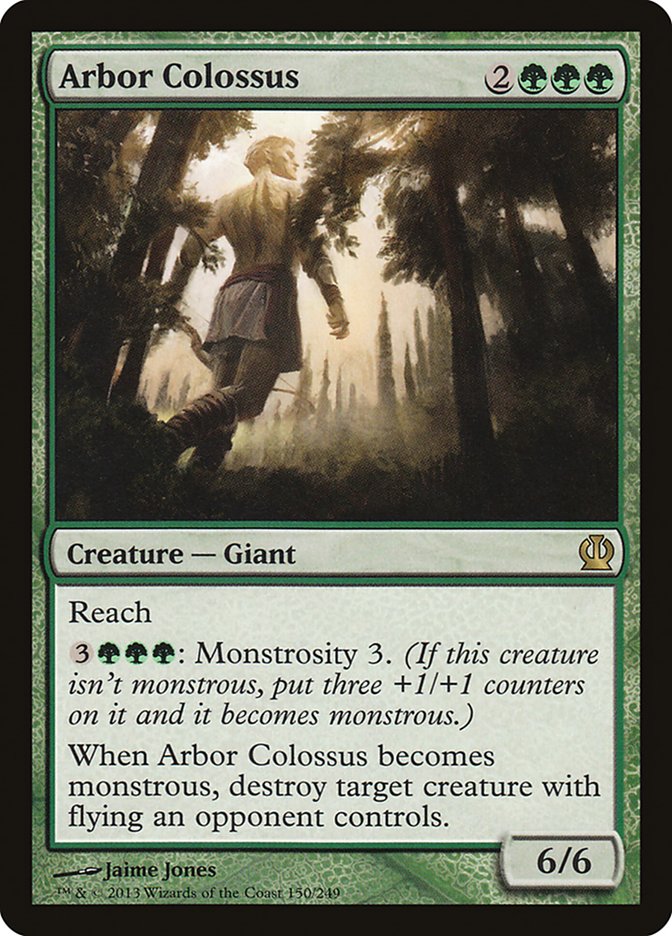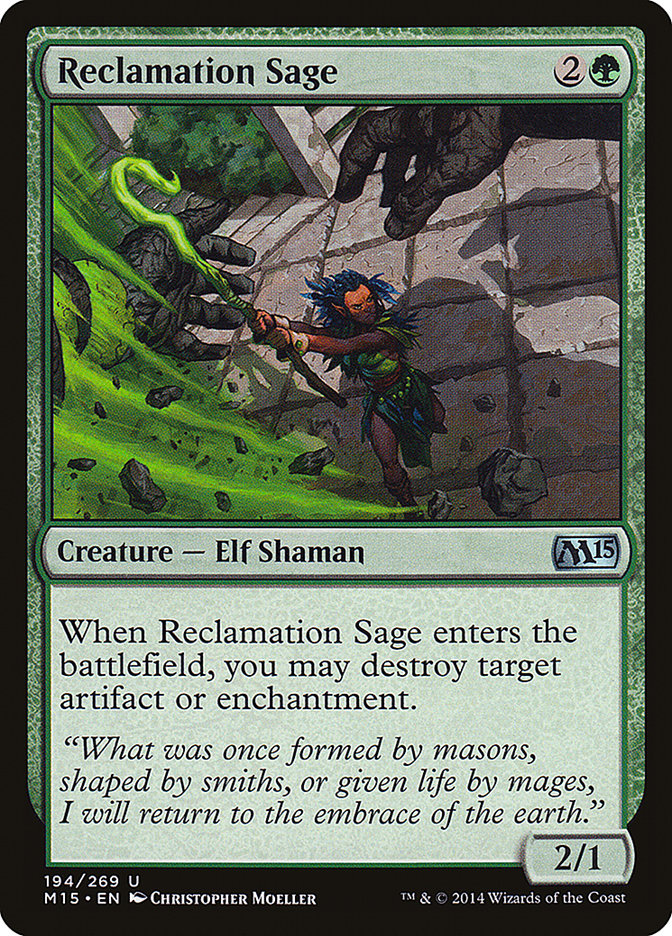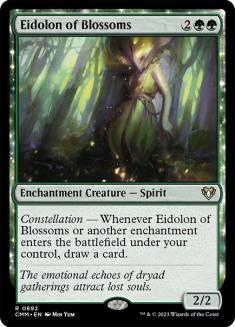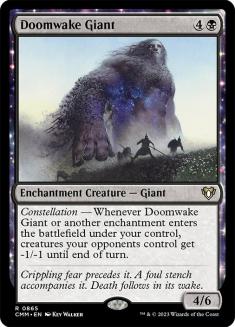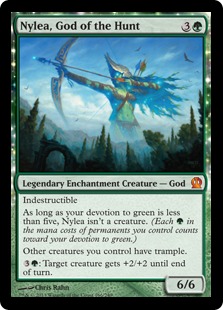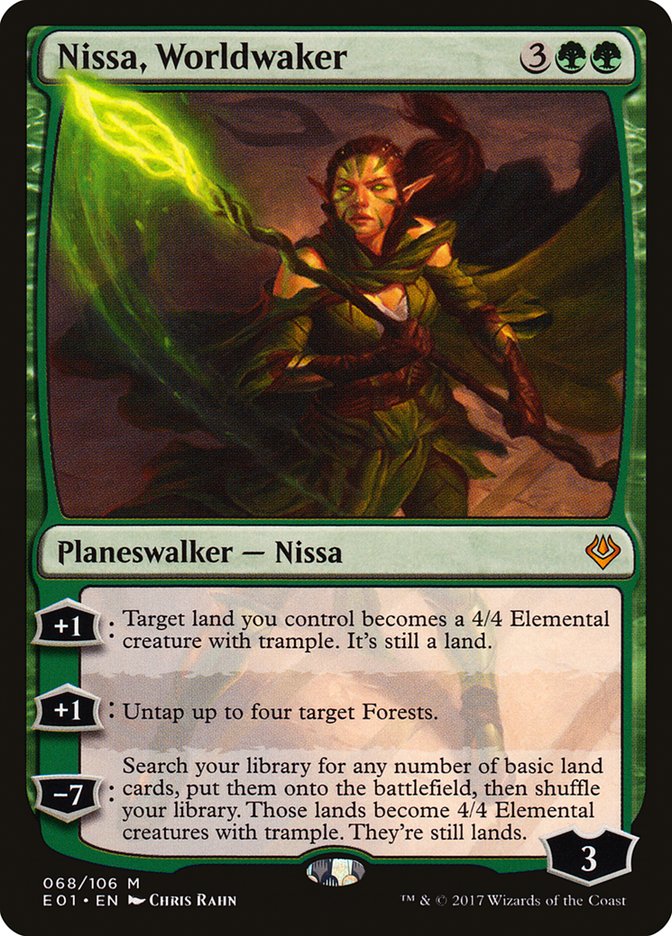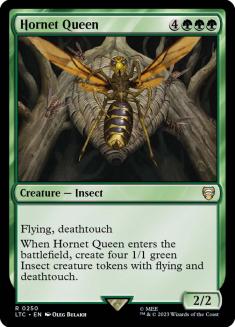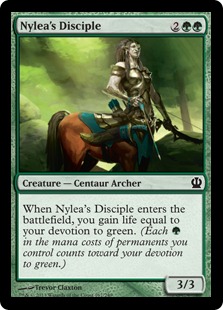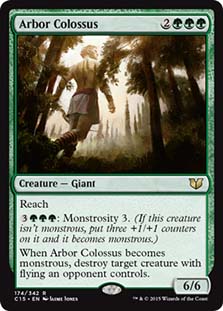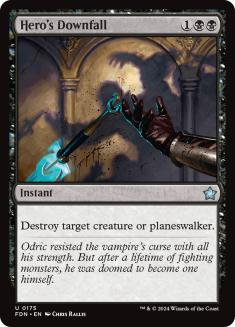There was a new set released? Are you sure? I think I would have noticed something like that. Really? Khans of Tarkir? That’s a weird name. Abzan? Temur?
You mean Junk and RUG, right? No one is going to use those silly names! Oh, everyone already uses them because it would be ridiculous not to? Okay then.
Well I’m not going to use any of those cards with funny names. I’ll just keep jamming basic lands and devotion cards. It’ll be fine.
Last weekend I made the semifinals of the Standard Open in New Jersey. Notably, my deck contained no cards from the new expansion, eschewing the exciting
multi-colored cards from Khans of Tarkir for the powerful devotion and constellation mechanics from Theros Block. Basic lands are still great, and I still
love throwing a pile of creatures onto the battlefield. In fact, my deck from last weekend had more creatures than Mono-Blue Devotion and even Legacy
Elves.
I will begin by writing about my testing experience over the last two weeks and how it led me to the deck choice I made. Afterwards, I will discuss the
list I used and how the tournament went, concluding with the impressions I gained of the format from seeing the results in New Jersey and Indianapolis.
Testing
I tried to build decks using the new cards. I really did. There were all sorts of Abzan and Sultai lists brewed over the last two weeks and a thoroughly
mediocre Temur Monsters list. I did not get very far with Mardu or Jeskai, feeling that although those wedges had potential, I lacked the time to find the
correct list with so many options not only for cards, but baseline strategy. My two losses in Edison this weekend were to those two clans, which is
disappointing but not at all surprising. There is always more you could have done.
My earliest testing revolved around building the obvious decks and playing them against each other in an attempt to determine the texture of the early
format. This preliminary step is often overlooked but is vital to success in unexplored formats. Everyone is excited to use new cards and get away from the
old news of the previous year. But brewing, just like every decision in Magic, is best done in an appropriate context rather than a vacuum. Establishing
how the obvious decks matched up against each other would allow me to make more informed decisions about the expected metagame and brew with a well-defined
direction.
This early gauntlet consisted of red and black aggressive decks, Abzan and Sultai midrange decks, and Naya and Temur ramp decks (akin to Monsters). I knew
I wanted to look at the Mardu and Jeskai options as well, but those clans were the most open ended so they would need to be tailored for a specific
metagame. The aggro decks were as fast and punishing as expected and performed especially well against the midrange decks, which either lacked enough early
plays or took too much damage from their lands. The ramp decks were unimpressive, and did not seem to be doing something powerful enough to justify the
natural inconsistency of playing 30+ cards dedicated to making mana.
The monster decks were important in ascertaining which of the pair of Stormbreath Dragon and Sarkhan, the Dragonspeaker would be favored. Most of these
types of decks would play more than four of either one but do not have room for the full eight, so establishing a hierarchy was important not only for
those decks, but for opposing ones as well. If Sarkhan underperformed, Banishing Light would be less desirable for example. Conversely, if the Dragon was
worse, the bar for expensive, four-toughness creatures would be raised significantly. I decided that the best way to answer this important question would
be to make every copy of either card play as a split card of the two and keep track of how often each card was cast. Sarkhan significantly outperformed
Stormbreath in this metric, as the versatility to function as a removal spell proved more useful than the aggressive power of the dragon’s monstrosity and
protection abilities. From then on, all splits favored the planeswalker.
As for other new cards that made an impact, I was particularly impressed by the two new X spells, Crater’s Claws and Icy Blast, which I had in my Temur
list. The former was very flexible, functioning as an early removal spell against aggro, an answer to planeswalkers against midrange, and a gamebreaker in
the lategame where it would often deal lethal damage. The latter, while much less versatile, was a great way to break open board stalls, which happen quite
frequently in Carytid/Courser mirrors. Seeing these cards do well cemented the notion that my base green decks needed to go bigger.
I hope I remember to add green mana, not blue.
I am no stranger to devotion fueled absurdity, and a little old time religion was the perfect solution. Hornet Queen was quickly identified as the most
powerful endgame in the format, and it fit perfectly into a Green Devotion build that could use the multitude of quality mana accelerants available. My
first list was as follows:
Creatures (29)
- 2 Hornet Queen
- 4 Elvish Mystic
- 4 Polukranos, World Eater
- 1 Nylea, God of the Hunt
- 4 Sylvan Caryatid
- 2 Arbor Colossus
- 2 Voyaging Satyr
- 4 Courser of Kruphix
- 2 Genesis Hydra
- 4 Rattleclaw Mystic
Planeswalkers (6)
Lands (24)
Spells (1)

I was drawn to a red splash to best use the powerful new mana accelerant in Rattleclaw Mystic. Xenagos, the Reveler was excellent in the previous format,
consistently overperforming in Devotion and Monsters decks alike. With Crater’s Claws impressing me earlier, I tried a single copy over the second Nylea in
what would be my stalemate-breaking slots. I figured this deck could produce so much mana that killing your opponent from even fifteen or more life would
be feasible, and unlike Nylea it could function when you are low on resources.
It may surprise you that I included so many accelerants, but I would much rather be on the too much mana side than the not enough in decks like this. It
has plenty of ways to use excess mana between the monsters, Nylea, and X spells. Missing land drops in your ramp decks is a death sentence, even worse than
in a normal deck since your mana creatures turn into expensive land drops. I was also hopeful that the 2/1 body on Rattleclaw Mystic could prove to be
useful, mitigating some of the risk of flooding on low impact cards.
My inclusion of only two copies of Genesis Hydra was admittedly rather arbitrary, but I expected the card to be worse in this version of the deck than in
versions from the previous format that had Domri Rade as a solid hit when X is set to three. In this list, you really need to cast Hydra for at least four
to have a reasonable chance of hitting something good, and even then you miss a reasonable portion of the time. I started at two, but as you saw I
eventually moved to the full set since I found hitting a mana creature was not as bad as I expected, and it is far and away the best topdeck the deck can
play.
The deck was quite good against my gauntlet, with Hornet Queen and Xenagos overperforming. Hornet Queen ended the game almost on impact against other ramp
decks, and forced the black midrange decks to have Bile Blights which were ineffective against the rest of your threats. Xenagos made mana more often than
Satyrs, allowing for explosive draws even without Nykthos. Even so, a swarm of Satyrs was good against aggressive and control decks alike. Crater’s Claws
was even more impressive in this deck than the Temur list, as it won the game even more frequently than I expected, and killed various planeswalkers that
were the best way for the midrange decks to turn the game around against our powerful but sometimes slow threats.
One card that disappointed was Nissa. She was too slow to be effective against aggressive decks and too often vulnerable to a reply of Sarkhan or
Stormbreath from the opposition. She was still quite good against removal heavy decks, but that to me indicated a sideboard card, not the core piece I
expected.
Even with Nissa and Xenagos as powerful, advantage gaining threats, G/R Devotion could struggle against the removal heavy black decks. As you may have
expected, I had too many mana sources in the deck and flooding was a real issue with the powerful removal available in this format able to deal with the
varied threats the deck presents. Shaving some of the mana accelerants allowed me to play more Genesis Hydras, which were excellent in these matchups.
I was hopeful for Devotion against aggressive decks, since it can quickly and consistently land threats like Courser and Polukranos that dominate the
board, and it does so with the least painful manabase of any non-aggro deck. Still, the aggro decks are adept at bypassing blockers between Frenzied
Goblin, Hammerhand, and Mogis’s Marauders, and the matchup preboard felt even at best. Fortunately, the deck has plenty of excellent sideboard options
between Magma Spray, Arc Lightning, and the powerhouse Nylea’s Disciple. An excellent post-board matchup left me feeling very comfortable about my spot.
As I expected, the power of the deck allowed it to go over the top of Monsters decks, with Hornet Queen being especially good since it was impossible for
them to do better than trading two turns and a Polukranos for it, and it matched up well against Elspeth, Sun’s Champion. Arbor Colossus provided a solid
defense against Sarkhan and Stormbreath, which otherwise provided the Monsters decks with an easy avenue to victory. Simply put, Devotion ramps faster and
stronger than Monsters.
Happy with the results of my testing over Prerelease weekend, I mentally locked in to G/R Devotion and set about trying to solve the mirror. Hornet Queen
was the issue, and while adding more Genesis Hydras let me find my copies more reliably, I wanted an answer to opposing Queens. Arc Lightning, which was
already in my sideboard for aggressive decks could get most of the way, but it was actively bad otherwise. The next card considered was Soul of Shandalar.
Its body matches up well against the other cards in the deck, and the ability can certainly take over a longer game against Hornet Queen. Still, something
about the card did not sit well with me, and a double-red spell could be dicey on the mana.
To be fair, I did not give Soul a fair shake because that Monday my prayers were answered. When trying to solve an obvious issue with Hornet Queen that a
friend’s Mardu deck had, someone in my Facebook testing group suggested Doomwake Giant. This was my response:
“How the **** did we spend all yesterday testing and not come up with Doomwake Giant?”
It destroyed aggro decks. It stopped Hornet Queen. It trumped Elspeth. It did everything. It would probably give you a liver if you needed one. That liver
would come from some poor human he killed, but it’s the thought that counts. Even the name was cool. Doomwake. Go ahead. Say it a few times. It rolls right
off the tongue. No one on the subway cares if you are a lunatic. It’s even more fun when you shout it.
“DOOMWAKE!”
To say I was excited was an understatement. I quickly brewed a list and posted it in the thread I had started to discuss the G/R list.
Creatures (36)
- 2 Hornet Queen
- 4 Elvish Mystic
- 4 Polukranos, World Eater
- 2 Nylea, God of the Hunt
- 4 Sylvan Caryatid
- 4 Voyaging Satyr
- 4 Courser of Kruphix
- 4 Eidolon of Blossoms
- 3 Doomwake Giant
- 1 Pharika, God of Affliction
- 4 Genesis Hydra
Lands (24)

Here is the accompanying post:
“This could be better than the red splash since you break the Hornet Queen battle open, have a robust card advantage engine against Downfall decks and
Doomwake against the aggro decks. Losing Arbor Colossus against Sarkhan and Butcher could be tough though.”
The Maindeck
I moved to a full set of Voyaging Satyrs over Rattelclaw Mystics because Satyr could potentially provide black mana by untapping a dual land, thereby
fueling Pharika activations or any double-black cards in the sideboard. Satyr was also better than Rattelclaw in the mirror, which was my primary concern.
Rattleclaw was a better standalone accelerant, making it better against removal-heavy decks. Lastly, I had some Festerglooms in early sideboards, so the
second point of toughness was desirable.
Eidolon of Blossoms was a natural complement to Doomwake Giant, having formed the foundation of powerful constellation decks in Theros Block Constructed.
Eidolon also replaced Xenagos on the curve and in function, as both cards help to provide resiliency in the face of removal.
As I noted, Genesis Hydra had over performed in my G/R lists, and the move to G/B cemented it as a core piece because it provided an easy way to increase
my enchantment density for the constellation engine. Both Eidolon and Doomwake get much better in multiples, so digging for extra copies is excellent.
Pharika was also a natural inclusion to help the constellation sub-theme, since making enchantment snakes is the easiest way to trigger your Doomwake
multiple times in the same turn to generate a true Plague Wind. The second Nylea took the place of Crater’s Claws to maintain the status quo of having two
stalemate breakers.
The deck tested incredibly well against aggressive strategies, as Doomwake Giant was largely unbeatable. Doomwake also provided the desired edge in the
mirror, taking out an Elf early and then killing their entire team once you assembled a large enough board. As I expected, the black splash gave up some
edge against the midrange decks, since you were more vulnerable to a pile of spot removal, but you still had great tools. I also thought that those decks
would be the least represented of the three pillars, since they performed the worst against aggro. I committed to playing the deck on Wednesday, still
needing to work out a sideboard.
The Sideboard
Here is a quick rundown of why I included the cards I did. As is all too common in Magic, I ran short on time and many of these cards were untested before
the event. If there is one place for significant improvement in my list, it is here.
The only card I knew I wanted was Nylea’s Disciple, which is an obvious inclusion to solidify an already good aggro match-up. I definitely did not want to
lose to small creatures and reach spells, so this was always a four-of.
Nissa was an easy choice to combat the black midrange decks. While Eidolon provided some resilience to removal, it was not a threat by itself in the way
Xenagos was, since the 2/2 body could be easily blanked by Sylvan Caryatid and Courser of Kruphix. Nissa’s 4/4s run away with the game early, and it can
provide extra mana if they aggressively kill your early creatures. It easily slots in for Doomwake Giant in these matchups, maintaining your curve.
While I had Festergloom for awhile, Doomwake made the effect redundant so I looked to other removal spells to help out against aggressive decks. Setessan
Tactics still gives me some nightmares from last season, and can be effective against all flavors of aggro, not just those with loads of 2/1s. It is also
strong in the mirror, either cementing an early mana advantage by killing a couple Elvish Mystics and Voyaging Satyrs or completely annihilating their
board in a protracted game.
Arbor Colossus was an easy inclusion since I was worried about large fliers in Sarkhan, Stormbreath Dragon, and Butcher of the Horde. I tried to squeeze
one into the maindeck, but it is a casualty of the constellation engine.
Reclamation Sage was meant to come in against the black aggro decks, Whip of Erebos, Banishing Light, and Constellation. With so many other powerful
enchantments in Theros Block, I expected Sage to be good against a varied field, but I only brought it in once. I suspect that has more to do with my
pairings, and I will continue to look to the versatile elf as I currently think he is quite underrated in the format. I briefly considered a split between
Reclamation Sage and Consign to Dust and would have had Consign had a strive cost of two mana instead of three. Still, I could see Consign being correct if
the mirror match and other constellation decks become popular.
Lastly, I wanted a card that could answer some problematic threats, mostly planeswalkers. I tested a lot against Sultai Midrange decks similar to the one
advocated by Shaheen Soorani here and Ashiok, Kiora, and Nissa
all posed problems when played before the Devotion deck has developed a strong board presence. Additionally, I wanted a card that could answer threats in
the mirror when behind. Typically, playing your own Polukranos after they play theirs is a losing proposition so I wanted to break that play pattern. The
only card I came up with to kill both Ashiok and Polukranos was Hero’s Downfall. I knew it would stretch the mana and perhaps I should have included a copy
or two of Jungle Hollow to support them, but I really like basic lands and I was excited to break out these bad boys for the first time in awhile.
I made a few tweaks to the deck to arrive at this list for the tournament:
Creatures (35)
- 2 Hornet Queen
- 4 Elvish Mystic
- 4 Polukranos, World Eater
- 1 Nylea, God of the Hunt
- 4 Sylvan Caryatid
- 4 Voyaging Satyr
- 4 Courser of Kruphix
- 4 Eidolon of Blossoms
- 4 Doomwake Giant
- 4 Genesis Hydra
Planeswalkers (1)
Lands (24)

Adding the fourth Doomwake Giant was suggested by Jarvis Yu (Thanks, Jarvis!), and I reasoned that the card is so good in multiples that it can function as
a stalemate breaker in the same way as a Nylea. I also swapped the maindeck Pharika with one of the Nissas in the sideboard since I thought the latter
would be better against the black midrange decks that Pharika was there to fight and was generally a more powerful card. I think I underestimated Pharika’s
power in the mirror and would not make this swap in hindsight. Nissa was sided out in every match I played, and looking at the results of both New Jersey
and Indianapolis that was not far below expectation.
As I stated above, the sideboard was untuned, which is evident by the abundance of two-ofs. I knew it was bad going in but without a good idea of the
complexion of the field I was not confident making any adjustments and resigned myself to relying on some positive variance. Certainly not my proudest
moment, but winning isn’t always pretty.
The Tournament
After settling on a final list Friday night, I was looking forward to a full night of sleep before a long day of tournament Magic. Unfortunately, our hotel
had other plans as we many players and SCG staff were unceremoniously inducted into what I like to call “Team Fire Drill.” We were awoken at 3 AM to the
blaring sound of a fire alarm, and despite my initial attempt to ignore it with a pillow over my face, I was made to get out of bed and evacuate the
building. As I milled about outside watching the firefighters investigate and hoping my collection was not about to be engulfed in flames, rumors swirled
about what had happened. To the nearest I could ascertain, there was smoke and possible fire emanating from the boiler room. It seemed to be quickly
contained, and I was back to sleep in about an hour, mildly perturbed about my misfortune but ready to move past it.
That spirit was quickly crushed when I was informed the next morning that due to the issues in the boiler room, we would not have a working shower. Knowing
that many others were in the same situation, I prepared for a long day of pungent aromas. Suffice it to say that the shower I took that night was arguably
more satisfying than making the top 8.
As for the tournament itself, they say a picture is worth a thousand words and I hope that is true because this report is getting long. The graphic below
explains about eighty percent of my tournament experience:
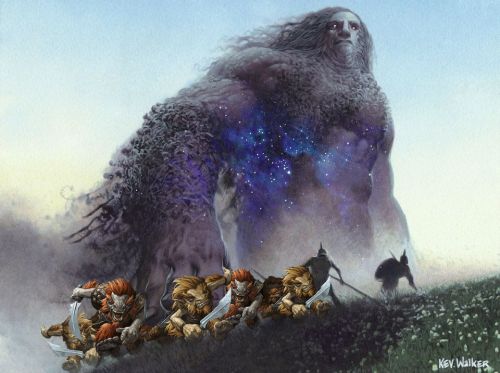
Over nine rounds of swiss (I took an intentional draw in round ten) and two elimination rounds, I played against five red aggro decks and two token aggro
decks (Mardu and Jeskai). I lost track of how many creatures Doomwake Giant killed, but probably somewhere around 3.8 trillion. Opponent after opponent
slumped in their chair upon seeing the 4/6 come in and wipe their board. By the end I could not help but laugh at how fortunate my pairings were. Nylea’s
Disciple was the all-star I expected it to be against red, consistently gaining 6-8 life thereby putting the game out of reach.
I won two devotion mirrors where Doomwake Giant was critical in either killing opposing mana creatures or breaking stalemates, just as I had suspected. I
clinched the top 8 by putting the fourth copy into play to kill three copies of Courser of Kruphix and set up a devastating attack. Earlier in the
tournament, I managed to put seven Doomwake Giant triggers on the stack in one turn to kill a monstrous Stormbreath Dragon. It was a blast.
Despite a few sloppy plays on my part in the quarterfinals, I Nylea-ed and Pharika-ed my way into a match with Kevin Jones and his Jeskai Tempo deck. I had
heard about the deck earlier in the day and it seemed like a terrible matchup on paper. It had cheap removal for my mana creatures, efficient threats
including Mantis Rider which I could not easily deal with, and plenty of reach to close out the game before I took control with my powerful creatures.
Kevin’s sideboard had three copies of Disdainful Stroke, which is tailor made for his deck to fight mine. Worst of all I had never played with or against
anything like his deck in testing, since my desire to brew for the Jeskai and Mardu clans seemed to always get pushed back.
All tournament long I had been fortunate to run into decks that I was well-prepared for, and my streak of good luck came to an end. I was offered some
fleeting hope with an easy game 1 in which Kevin tried to play a control role for which his maindeck was ill-equipped, and I landed some Doomwakes and took
over.
When sideboarding, I expected Kevin to bring out his ground creatures since I was well-equipped to contain them. He had an extra copy of Sarkhan to bring
in, the aforementioned Disdainful Strokes, and some Magma Sprays to kill my mana creatures. I wanted to bring out my slower cards, mainly Hornet Queen,
Doomwake Giant, Nylea, and Nissa, in the hopes that I could accelerate into more impactful threats early and keep him on the defensive long enough to get
to my haymakers. I also did not like Eidolon of Blossoms since I would be cutting several enchantments and it matches up poorly with Magma Spray and Mantis
Rider. Arbor Colossus would be necessary to block Mantis Rider and Sarkhan, and Nylea’s Disciple would blunt the effectiveness of his burn spells while
dodging Magma Spray. I decided to bring in the Downfalls to help against Mantis Rider and Sarkhan. Lastly, I brought in Pharika due to Kevin’s willingness
to kill my creatures in the first game. That left me sideboarding like this for the second game:
Out:
In:
In the second game, Kevin played a Mantis Rider on his third turn, and I was left with the option of playing a Polukranos, or Courser of Kruphix and Elvish
Mystic. I went with the latter and now believe it was a clear mistake. Courser was not going to do anything in combat against Mantis Rider and I clearly
need to race. I had two copies of Nylea’s Disciple in my hand so depending on Kevin’s hand I have a good chance of doing so if I get on the board quickly.
Polukranos is certainly the best play for that plan. I quickly fell behind to his counter spells and despite gaining some life a second copy of Mantis
Rider quickly ended the game.
For game three, I decided to bring in a single Setessan Tactics as a way to make use of my Coursers against Mantis Rider, cutting the fourth Doomwake Giant
as I was now fairly sure Kevin had brought out his ground creatures. I mulliganed a hand without any play for the first three turns into a six-carder with
acceleration and a Pharika. In a reversal from the previous game, Kevin came out very slowly, content to make land drops and set up his draws with a Magma
Jet targeting me. I suspected he had some countermagic in his hand and held my bigger threats (Polukranos and Arbor Colossus) in an attempt to get him to
tap out so I could land one. Once again, I regretted my decision after the game. Kevin had actually sideboarded into a more controlling list with Anger of
the Gods, Keranos, God of Storms, and Narset, Enlightened Master. When he missed some early land drops, I was too timid to punish him, and gave him the
necessary time to set up. An Anger of the Gods for my mana creatures made my Pharika look embarrassing, and all I managed was a few pings with a Snake
token before he killed me with a flurry of burn spells.
It was a disappointing result, but more disappointing was my play in those final two games. Twice I consciously conceded precious time, which is the key
resource against any tempo deck. I could say that my draws likely would not have been enough to carry the day even with better play or lament how difficult
it is to devise a good strategy on the fly, but that is what is required to win tournaments and I expect better of myself. Congratulations to Kevin for
coming with an innovative deck and being better prepared than I was. His winner’s interview was particularly impressive, demonstrating the articulation
that only comes with true understanding and preparation.
My Impressions of the Format
In looking over the results from this weekend, (both Edison and Indianapolis) I was unsurprisingly struck by the sheer volume of green decks represented.
There was plenty of hype around Sylvan Caryatid and Courser of Kruphix and in week one they lived up to the billing. I suspect that this is more a function
of players taking a safer route with their decks and that as the format is further explored, the less effective of these decks will fall off and the
prevalence of ramp decks overall will wane. In particular, I am not fond of the monsters style lists, since they exist in an awkward space between the
midrange and ramp decks and gain no true advantage for doing so.
Even more surprising was the dearth of aggressive strategies among the top decks. I speculated in my article two weeks ago that there was so much talk of other decks that
the aggressive decks that are typically championed in post-rotation formats could become overlooked and underrated. This was clearly not the case. Everyone
came prepared and in accordance with my testing, the aggressive decks do not have a clear answer to the very powerful sideboard cards other decks can
employ. If you want to get aggressive, you are going to have to approach it from a different angle, asKevin Jones and Jadine Klomparens did with their Jeskai Tempo decks.
Answering the assured influx of Jeskai Tempo is the critical question for anyone looking to play Green Devotion, regardless of the splash employed.
Unfortunately, it is a matchup whose issues originate at the deepest strategic level. Tempo decks employ cheap answers to large threats and when you give
them time to set up your mana you play right into their strategy. It is paramount to get ahead early and keep pressuring them, not allowing them to turn
the corner and take the aggressive role. Eidolon of Blossoms and Doomwake Giant are ill-equipped for this type of gameplan, and with an expected decline in
the popularity of aggro decks, the black splash may easily be a poor choice moving forward.
Unfortunately, the red splash does not currently offer much. Xenagos, the Reveler matches up very poorly against Mantis Rider, and while efficient removal
like Lightning Strike would be good, it is unlikely to turn the matchup around. Sarkhan, the Dragonspeaker could be reasonable since it can kill a Mantis
Rider or trade for two burn spells while getting in a significant chunk of damage. However, the mana is tough and I fear adding a card like that would
dilute the devotion engine. While beating Jeskai Tempo will be important, it should not come at the expense of the deck’s core strengths.
You will certainly want to include some maindeck copies of Arbor Colossus, likely over some of the Doomwake Giants, or in place of entirely if you move to
a different splash color. Perhaps a cheap threat like Boon Satyr that has some upside later on could be effective. Satyr can be a functional five mana
spell that dodges Disdainful Stroke, but as a three-drop is vulnerable to both Lightning Strike and Magma Jet. Personally, I think the Jeskai Tempo deck is
very good and will be a pillar of the new metagame, so I will be putting in a lot of time trying to solve this match-up before SCG Autumn States and the
Open Weekend in Worcester next month.
The other major issue to deal with is End Hostilities. With so many green ramp decks doing well last weekend, this card is poised to become very popular.
Fortunately, this is a card that the black splash is well-poised to fight. An extra Pharika lets you re-use the lost creatures and if you hold back an
Eidolon of Blossoms you can recoup the card advantage. In addition, black gives you access to effective discard in Thoughtseize and Brain Maggot to
potentially strip the sweeper from your opponent’s hand before they can play it. Thoughtseize is an obviously powerful card, but Maggot provides synergy
with devotion. Either way, both are solid options against potential control decks.
I hope I have offered some insight into how I arrived at the G/B Devotion deck and a springboard of ideas for how to improve it in the coming weeks. If any
of you have ideas for improvements you will be working on, let me know.


